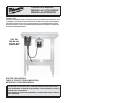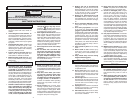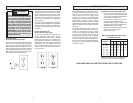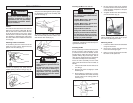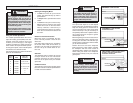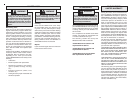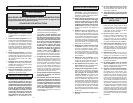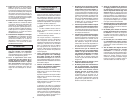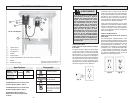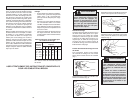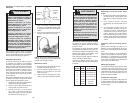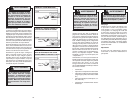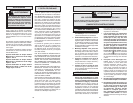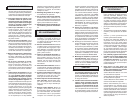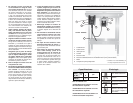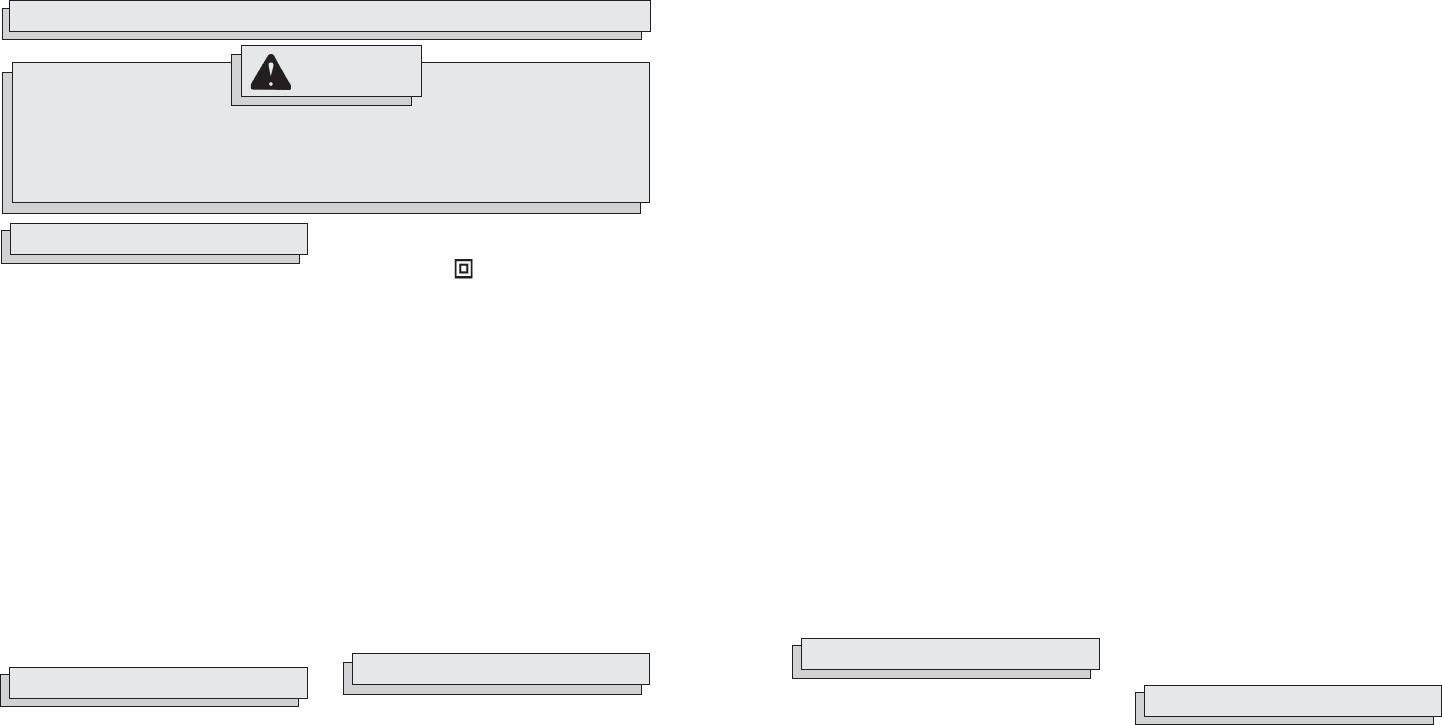
2 3
WORK AREA
ELECTRICAL SAFETY
PERSONAL SAFETY
WARNING
READ AND UNDERSTAND ALL INSTRUCTIONS
Failure to follow all instructions listed below, may result in electric shock, fi re
and/or serious personal injury.
SAVE THESE INSTRUCTIONS
GENERAL SAFETY RULES
TOOL USE AND CARE
SERVICE
1. Keep work area clean and well lit.
Cluttered, dark work areas invite ac-
cidents.
2. Avoid dangerous environments. Do
not use your power tool in rain, damp or
wet locations or in the presence of ex-
plosive atmospheres (gaseous fumes,
dust or fl ammable materials). Remove
materials or debris that may be ignited
by sparks.
3. Keep bystanders away. Children and
bystanders should be kept at a safe
distance from the work area to avoid
distracting the operator and contacting
the tool or extension cord.
4. Protect others in the work area from
debris such as chips and sparks. Pro-
vide barriers or shields as needed.
5. Make workshop child proof with pad-
locks, master switches, or by removing
starter keys.
6.
Grounded tools must be plugged
into an outlet properly installed and
grounded in accordance with all
codes and ordinances. Never remove
the grounding prong or modify the plug in
any way. Do not use any adaptor plugs.
Check with a qualifi ed electrician if you
are in doubt as to whether the outlet is
properly grounded. If the tool should
electrically malfunction or break down,
grounding provides a low resistance path
to carry electricity away from the user.
7. Double insulated tools are equipped
with a polarized plug (one blade is
wider than the other). This plug will
fi t in a polarized outlet only one way.
If the plug does not fi t fully in the
outlet, reverse the plug. If it still does
not fi t, contact a qualifi ed electrician
11. Know your power tool. Read this
manual carefully to learn your power
tool’s applications and limitations as well
as potential hazards associated with this
type of tool.
12. Stay alert, watch what you are do-
ing, and use common sense when
operating a power tool. Do not use
tool while tired or under the infl uence
of drugs, alcohol, or medication. A
moment of inattention while operating
power tools may result in serious per-
sonal injury.
13. Dress properly. Do not wear loose
clothing or jewelry. Wear a protective
hair covering to contain long hair. These
ma
y be caught in moving parts. When
working outdoors, wear rubber gloves and
insulated non-skid footwear. Keep hands
and gloves away from moving parts.
21. Secure work. Use clamps or a vise to
hold work when practical. It is safer than
using your hand and it frees both hands
to operate the tool.
22. Do not force tool. Your tool will per-
form best at the rate for which it was
designed. Excessive force only causes
operator fatigue, increased wear and
reduced control.
23. Use the right tool. Do not use a tool or
attachment to do a job for which it is not
recommended. For example, do not use
a circular saw to cut tree limbs or logs.
Do not alter a tool.
24. Unplug tool when it is not in use, before
changing accessories or performing
recommended maintenance.
25. Store idle tools. When not in use, store
your tool in a dry, secured place. Keep
out of reach of children.
to install a polarized outlet. Do not
change the plug in any way. Double
insulation eliminates the need for
the three wire grounded power cord and
grounded power supply system.
8. Guard against electric shock. Prevent
body contact with grounded surfaces
such as pipes, radiators, ranges and re-
frigerators. When making blind or plunge
cuts, always check the work area for
hidden wires or pipes. Hold your tool by
insulated nonmetal grasping surfaces.
Use a Ground Fault Circuit Interrupter
(GFCI) to reduce shock hazards.
9. Do not expose to rain or use in damp
locations.
10. Do not abuse the cord. Never use
the cord to carry the tools or pull the
plug from an outlet. Keep cord away
form heat, oil, sharp edges or mov-
ing parts. Replace damaged cords
immediately. Damaged cords increase
the risk of electric shock.
14. Reduce the risk of unintentional
starting. Be sure your tool is turned off
before plugging it in. Do not use a tool if
the power switch does not turn the tool
on and off. Do not carry a plugged-in
tool with your fi nger on the switch.
15. Remove all adjusting keys and
wrenches. Make a habit of checking
that adjusting keys, wrenches, etc. are
removed from the tool before turning it
on.
16. Do not overreach. Maintain control.
Keep proper footing and balance at all
times.
17. Use safety equipment. Everyone
in the work area should wear safety
goggles or glasses with side shields
complying with current safety standards.
Everyday eyeglasses only have impact
resistant lenses. They are not safety
glasses. Wear hearing protection during
extended use and a dust mask for dusty
operations. Hard hats, face shields,
safety shoes, etc. should be used when
specifi ed or necessary. Keep a fi re ex-
tinguisher nearby.
18. Keep guards in place and in working
order.
19. Never stand on tool. Serious injury
could occur if the tool is tipped or if
the cutting tool is unintentionally con-
tacted.
20. Keep hands away from all cutting
edges and moving parts.
26. Never leave the tool running unat-
tended. Turn power off. Do not leave the
tool until it comes to a complete stop.
27. Check for damaged parts. Inspect
guards and other parts before use.
Check for misalignment, binding of
moving parts, improper mounting,
broken parts and any other conditions
that may affect operation. If abnormal
noise or vibration occurs, turn the tool
off immediately and have the problem
corrected before further use. Do not
use a damaged tool. Tag damaged tools
“DO NOT USE” until repaired. A guard or
other damaged part should be properly
repaired or replaced by a MILWAUKEE
service facility. For all repairs, insist on
only identical replacement parts.
28. Use proper accessories. Consult this
manual for recommended accessories.
Using improper accessories may be
hazardous. Be sure accessories are
properly installed and maintained. Do
not defeat a guard or other safety device
when installing an accessory or attach-
ment.
29. Maintain tools carefully. Keep cutting
edges sharp and clean. Follow instruc-
tions for lubricating and changing acces-
sories. Periodically inspect tool cords
and extension cords for damage. Have
damaged parts repaired or replaced by
a MILWAUKEE service facility.
30. Maintain labels & nameplates. These
carry important information. If unread-
able or missing, contact a MILWAUKEE
service facility for a free replacement.
31. Tool service must be performed only
by qualifi ed repair personnel. Service
or maintenance performed by unquali-
fi ed personnel may result in a risk of
injury.
32. When servicing a tool, use only iden-
tical replacement parts. Follow in-
structions in the maintenance section
of this manual. Use of unauthorized
parts or failure to follow maintenance
instructions may create a risk of shock
or injury.



